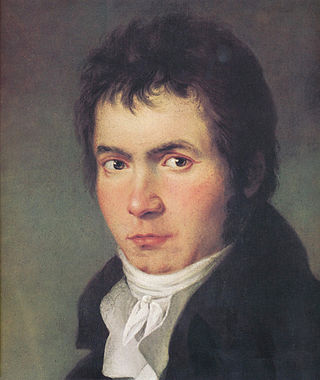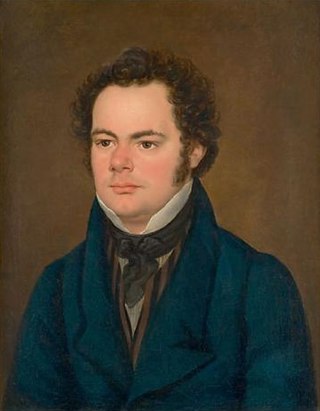In western classical music, the sonata cycle is a multi-movement structure used in a concerto, symphony or sonata.
In western classical music, the sonata cycle is a multi-movement structure used in a concerto, symphony or sonata.
In the field of music theory, the term Sonata Cycle refers to the layout of a multi-movement work where the movements are recognizably in the forms of the tradition of classical music. It differs from the term cyclic form in that there is no unifying motive or theme used in all the movements. The standard sonata cycle has four movements, broken down as follows:
The first movement is, by definition, written in sonata form, in a fast tempo (allegro), and in the home key of the overall piece. This movement can also be called the sonata-allegro.
The second movement is usually written in a slow tempo, in another key, and in one of a variety of forms such as theme and variations, compound ternary form, rondo, or sonata.
The third movement usually follows a dance-like form, such as Minuet [or Scherzo] and Trio form. It is commonly written in the home key. Or, if used as the last movement, is in a fast tempo such as prestissimo, presto, or vivace. Like in Beethoven's "Pathetique" sonata Op.13 Third Movement
The fourth movement is written in the home key, and may use rondo, sonata, or theme and variations form, among others.
For more detail see Sonata.
In reference to performance or recording, Sonata Cycle almost always means the complete traversal of a set of works by a single composer. For example, a "Beethoven sonata cycle" would refer to a performer playing all of Beethoven's piano sonatas.
Sonata form is a musical structure generally consisting of three main sections: an exposition, a development, and a recapitulation. It has been used widely since the middle of the 18th century.
The rondo is a musical form that contains a principal theme which alternates with one or more contrasting themes, generally called "episodes", but also occasionally referred to as "digressions" or "couplets". Some possible patterns include: ABACA, ABACAB, ABACBA, or ABACABA.
Ludwig van Beethoven's Piano Sonata No. 8 in C minor, Op. 13, commonly known as Sonata Pathétique, was written in 1798 when the composer was 27 years old, and was published in 1799. It has remained one of his most celebrated compositions. Beethoven dedicated the work to his friend Prince Karl von Lichnowsky. Although commonly thought to be one of the few works to be named by the composer himself, it was actually named Grande sonate pathétique by the publisher, who was impressed by the sonata's tragic sonorities.

The Symphony No. 8 in F major, Op. 93 is a symphony in four movements composed by Ludwig van Beethoven in 1812. Beethoven fondly referred to it as "my little Symphony in F", distinguishing it from his Sixth Symphony, a longer work also in F.

Eine kleine Nachtmusik, K. 525, is a 1787 composition for a chamber ensemble by Wolfgang Amadeus Mozart (1756–1791). The German title means "a little night music". The work is written for an ensemble of two violins, viola, cello and double bass, but is often performed by string orchestras. The serenade is one of Mozart's most famous works.
Symphony No. 103 in E♭ major is the eleventh of the twelve London symphonies written by Joseph Haydn. This symphony is nicknamed The Drumroll after the long roll on the timpani with which it begins. It is from 1795, and his second-to-last symphony.

Beethoven's Piano Sonata No. 21 in C major, Op. 53, known as the Waldstein, is one of the three most notable sonatas of his middle period. Completed in summer 1804 and surpassing Beethoven's previous piano sonatas in its scope, the Waldstein is a key early work of Beethoven's "Heroic" decade (1803–1812) and set a standard for piano composition in the grand manner.
A sonatina is a small sonata. As a musical term, sonatina has no single strict definition; it is rather a title applied by the composer to a piece that is in basic sonata form, but is shorter and lighter in character, or technically more elementary, than a typical sonata. The term has been in use at least since the late baroque; there is a one-page, one-movement harpsichord piece by Handel called "Sonatina". It is most often applied to solo keyboard works, but a number of composers have written sonatinas for violin and piano, for example the Sonatina in G major for Violin and Piano by Antonín Dvořák, and occasionally for other instruments, for example the Clarinet Sonatina by Malcolm Arnold.
Ludwig van Beethoven's Piano Sonata No. 3 in C major, Op. 2, No. 3, is a sonata written for solo piano, composed in 1795. It is dedicated to Joseph Haydn and is often referred to as one of Beethoven's earliest "grand and virtuosic" piano sonatas. All three of Beethoven's Op. 2 piano sonatas contain four movements, an unusual length at the time, which seems to show that Beethoven was aspiring towards composing a symphony. It is both the weightiest and longest of the three Op. 2 sonatas, and it presents many difficulties for the performer, including difficult trills, awkward hand movements, and forearm rotation. It is also one of Beethoven's longest piano sonatas in his early period. With an average performance lasting just about 24–26 minutes, it is second only to the Grand Sonata in E♭ Major, Op. 7, published just a year later, in 1796.

Ludwig van Beethoven composed his Piano Sonata No. 12 in A♭ major, Op. 26, in 1800–1801, around the same time as he completed his First Symphony. He dedicated the sonata to Prince Karl von Lichnowsky, who had been his patron since 1792.

Ludwig van Beethoven's Piano Concerto No. 1 in C major, Op. 15, was written in 1795, then revised in 1800. It was possibly first performed by Beethoven at his first public concert in Vienna on 29 March 1795. It was first published in 1801 in Vienna with dedication to his pupil Princess Anna Louise Barbara Odescalchi, known to her friends as "Babette".
The Piano Sonata No. 19 in G minor, Op. 49, No. 1, and Piano Sonata No. 20 in G major, Op. 49, No. 2, are short sonatas by Ludwig van Beethoven, published in 1805. Both works are approximately eight minutes in length, and are split into two movements. These sonatas are referred to as the Leichte Sonaten to be given to his friends and students.

The Piano Sonata No. 10 in G major, Op. 14, No. 2, composed in 1798–1799, is an early-period work by Ludwig van Beethoven, dedicated to Baroness Josefa von Braun. A typical performance lasts 15 minutes. While it is not as well known as some of the more original sonatas of Beethoven's youth, such as the Pathétique or Moonlight sonatas, Donald Francis Tovey described it as an 'exquisite little work.'
Beethoven's Piano Sonata No. 11 in B♭ major, Op. 22, was composed in 1800, and published two years later. Beethoven regarded it as the best of his early sonatas, though some of its companions in the cycle have been at least as popular with the public.

Piano Sonata No. 13 in E-flat major, Op. 27 No. 1, "Quasi una fantasia", is a sonata composed by Ludwig van Beethoven in 1800–1801.
Cello Sonatas No. 1 and No. 2, Op. 5, are two sonatas for cello and piano written by Ludwig van Beethoven in 1796, while he was in Berlin. While there, Beethoven met the King of Prussia Friedrich Wilhelm II, an ardent music-lover and keen cellist. Although the sonatas are dedicated to Friedrich Wilhelm II, Ferdinand Ries tells us that Beethoven "played several times at the court, where he also played the two cello sonatas, opus 5, composed for Duport and himself". Although Jean-Pierre Duport was one of the King's teachers, it is now thought to have been his brother Jean-Louis Duport who had the honor of premiering these sonatas.
The Piano Sonata No. 3 in F minor, Op. 5 of Johannes Brahms was written in 1853 and published the following year. The sonata is unusually large, consisting of five movements, as opposed to the traditional three or four. When he wrote this piano sonata, the genre was seen by many to be past its heyday. Brahms, enamored of Beethoven and the classical style, composed Piano Sonata No. 3 with a masterful combination of free Romantic spirit and strict classical architecture. As a further testament to Brahms' affinity for Beethoven, the Piano Sonata is infused with the instantly recognizable motive from Beethoven's Symphony No. 5 during the first, third, and fourth movements. Composed in Düsseldorf, it marks the end of his cycle of three sonatas, and was presented to Robert Schumann in November of that year; it was the last work that Brahms submitted to Schumann for commentary. Brahms was barely 20 years old at its composition. The piece is dedicated to Countess Ida von Hohenthal of Leipzig.

Franz Schubert's last three piano sonatas, D 958, 959 and 960, are his last major compositions for solo piano. They were written during the last months of his life, between the spring and autumn of 1828, but were not published until about ten years after his death, in 1838–39. Like the rest of Schubert's piano sonatas, they were mostly neglected in the 19th century. By the late 20th century, however, public and critical opinion had changed, and these sonatas are now considered among the most important of the composer's mature masterpieces. They are part of the core piano repertoire, appearing regularly on concert programs and recordings.
A slow movement is a form in a multi-movement musical piece. Generally, the second movement of a piece will be written as a slow movement, although composers occasionally write other movements as a slow movement as well. The tempo of a slow movement can vary from largo to andante. It is usually in the dominant, subdominant, parallel, or relative key of the musical work's main key.

The Piano Quartets, WoO 36, by Ludwig van Beethoven are a set of three piano quartets, completed in 1785 when the composer was aged 14. They are scored for piano, violin, viola and cello. He composed a quartet in C major, another in E-flat major, and a third in D major. They were first published posthumously in 1828, however numbered in a different order: Piano Quartet No. 1 in E-flat major, Piano Quartet No. 2 in D major, and Piano Quartet No. 3 in C major.
All of the musical terms above are in Wikipedia itself, and in The New Grove Dictionary of Music and Musicians, second edition, edited by Stanley Sadie and John Tyrrell. London: Macmillan Publishers. And in the online version Oxford Music Online. Although the latter website is by subscription, university and public libraries usually have a subscription to it.